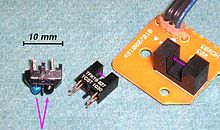Photoelectric barrier
In optoelectronics, a light barrier is a system that detects the interruption of a light beam and displays it as an electrical signal. In this way, automatic devices can detect moving objects without contact. For example, obstacles in the case of automatically closing doors can be detected or intruders through alarm systems .
functionality
Light barriers consist of a light beam source (the transmitter) and a sensor (the receiver) for this radiation.
Light- emitting diodes with a wavelength of 660 nm (visible red light) or infrared LEDs with 880–940 nm in the infrared range are used as light sources . Infrared light has the advantage of achieving a greater range on dark materials, and it is also not visible to the human eye. The advantage of red light is that the sensor system is easier to set thanks to the visible light spot. For particularly precise applications (small part detection, high repeat accuracy ) i. d. Usually light from a laser diode used. The receiver is usually a photodiode or a phototransistor , more rarely a photoresistor .
In order to make a light barrier insensitive to external light, the radiation, especially in long-range models, is modulated in order to be able to distinguish it from the ambient light. In addition, an infrared filter that appears almost black to the human eye can be attached in front of the receiver in order to shield higher-frequency light, including the visible part of daylight.
To increase the range, the transmitter and receiver are usually provided with an optically bundling system, such as a collecting lens . In addition, the photodiodes and phototransistors can be mounted in a cylindrical sheet metal housing that fades out sidelight, into whose circular opening a small lens made of plastic or glass is pressed in a defined manner. The housings of small transmitters and receivers are often made entirely of black plastic, which is only transparent for IR.
In order to save an electrical supply line to a second location, the transmitter and receiver are often integrated close to each other but optically separated in a housing and are aimed precisely at a retroreflector to form the light barrier, which is usually formed from cube corners on the back of a plastic plate.
Types
A distinction is mainly made between the types of through-beam photoelectric switch, photoelectric reflex switch and light grid.
One-way photoelectric switch
In the case of one-way light barriers, the sender and receiver face each other. These include fork couplers and fork light barriers in which the transmitter and receiver are preassembled at a distance of 3–120 mm from one another. If the transmitter and receiver are in separate housings, they must be aligned with one another during assembly and fine-tuned with adjusting screws. One-way light barriers have the greatest range of all types of up to 80 m.
Photoelectric reflex switch
The transmitter and receiver are located parallel to one another in a common housing. The light signal is reflected on the opposite side at a reflector. Small photoelectric retro-reflective sensors are also known as reflex couplers ; they often work with reflective, self-adhesive film marks on moving parts.
The versions with reflector differ in terms of the use of a polarization filter . Versions with a polarization filter only work with a retroreflector or reflector, but not with a smooth mirror surface. Such is recognized as an interruption; this creates additional security, since z. B. also a bare metal object is reliably recognized as an interruption. The use of retroreflectors and photoelectric retro-reflective sensors simplifies their installation considerably due to the reduced cabling effort and since no precise alignment of the reflector with the photoelectric sensor is required.
Photoelectric proximity switch
With these, the light signal is reflected back over the object to be detected. The switching distance therefore depends on the reflection properties of the object surface. Here, too, the transmitter and receiver are located parallel to one another in a common housing.
In addition to the purely energetic photoelectric proximity switches, the photoelectric proximity switches with background suppression are of great practical importance, as they are able to detect dark objects against a light background. If they are also able to determine the distance, they are called distance sensors - they then usually work on the principle of triangulation and contain a position-sensitive photodiode (PSD) instead of the phototransistor. These can be used to set up photoelectric proximity switches that can differentiate between different objects (e.g. on a conveyor belt). There are also distance sensors with a switching function that work on the principle of time -of-flight measurement (see electro-optical distance measurement ). They achieve a greater range than photoelectric proximity switches (up to 75 m).
See also reflex coupler .
Light curtain
In addition to the simple versions with only one light beam, there are also so-called light grids or light curtains that work with several parallel light beams. With these a large area can be monitored, e.g. B. access to a machine or an alarm-protected room. With a light grille, openings in building elevator cars are much better protected than with a single light barrier at ankle height, as was standard until 1970.
Fiber optic light barrier
There are also fiber optic sensors in which optics and electronics are arranged separately and connected by means of light guides . They are used, for example, in tight spaces. One-way and reflection light barriers are possible.
literature
[1] Light barriers: technology and applications

